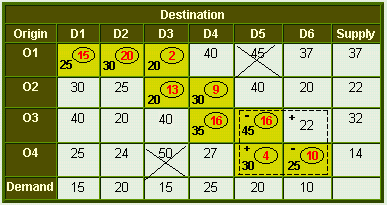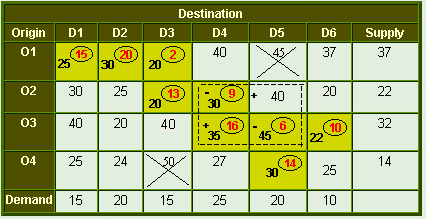Time Minimizing Transportation Problem
In the Time Minimizing Transportation Problem the objective is to minimize the time.
This problem is same as the transportation problem of minimizing the cost, expect that the unit transportation cost is replaced by the time tij.
 Steps in Time Minimizing Problem
Steps in Time Minimizing Problem
1. Determine an initial basic feasible solution using any one of the following:
2. Find Tk for this feasible plan and cross out all the unoccupied cells for which tij ≥ Tk.
3. Trace a closed path for the occupied cells corresponding to Tk. If no such closed path can be formed, the solution obtained is optimum otherwise, go to step 2.
 Example 1: Time Minimizing Transportation Problem
Example 1: Time Minimizing Transportation Problem
The following matrix gives data concerning the transportation times tij
| Destination | |||||||
|---|---|---|---|---|---|---|---|
| Origin | D1 | D2 | D3 | D4 | D5 | D6 | Supply |
| O1 | 25 | 30 | 20 | 40 | 45 | 37 | 37 |
| O2 | 30 | 25 | 20 | 30 | 40 | 20 | 22 |
| O3 | 40 | 20 | 40 | 35 | 45 | 22 | 32 |
| O4 | 25 | 24 | 50 | 27 | 30 | 25 | 14 |
| Demand | 15 | 20 | 15 | 25 | 20 | 10 | |
Solution.
We compute an initial basic feasible solution by north west corner rule which is shown in table 1.
Table 1
| Destination | |||||||
|---|---|---|---|---|---|---|---|
| Origin | D1 | D2 | D3 | D4 | D5 | D6 | Supply |
| O1 | 40 | 45 | 37 | 37 | |||
| O2 | 30 | 25 | 40 | 20 | 22 | ||
| O3 | 40 | 20 | 40 | 22 | 32 | ||
| O4 | 25 | 24 | 50 | 27 | 14 | ||
| Demand | 15 | 20 | 15 | 25 | 20 | 10 | |
Here, t11 = 25, t12 = 30, t13 = 20, t23 = 20, t24 = 30, t34= 35, t35 = 45, t45 =30, t46 = 25
Choose maximum from tij, i.e., T1 = 45. Now,
cross out all the unoccupied cells that are ≥
T1.
The unoccupied cell (O3D6) enters into the basis as shown in table 2.
Table 2

Choose the smallest value with a negative position on the closed path, i.e., 10. Clearly only 10 units can be shifted to the entering cell. The next feasible plan is shown in the following table.
Table 3
| Destination | |||||||
|---|---|---|---|---|---|---|---|
| Origin | D1 | D2 | D3 | D4 | D5 | D6 | Supply |
| O1 | 40 | 37 | 37 | ||||
| O2 | 30 | 25 | 40 | 20 | 22 | ||
| O3 | 40 | 20 | 40 | 32 | |||
| O4 | 25 | 24 | 27 | 25 | 14 | ||
| Demand | 15 | 20 | 15 | 25 | 20 | 10 | |
Here, T2 = Max(25, 30, 20, 20, 20, 35, 45, 22, 30) = 45.
Now, cross out all the unoccupied cells that are ≥
T2.
Table 4

By following the same procedure as explained above, we get the following revised matrix.
Table
| Destination | |||||||
|---|---|---|---|---|---|---|---|
| Origin | D1 | D2 | D3 | D4 | D5 | D6 | Supply |
| O1 | 37 | 37 | |||||
| O2 | 30 | 25 | 20 | 22 | |||
| O3 | 20 | 32 | |||||
| O4 | 25 | 24 | 27 | 25 | 14 | ||
| Demand | 15 | 20 | 15 | 25 | 20 | 10 | |
T3 = Max(25, 30, 20, 20, 30, 40, 35, 22, 30) = 40. Now,
cross out all the unoccupied cells that are ≥
T3.
Now we cannot form any other closed loop with T3.
Hence, the solution obtained at this stage is optimal.
Thus, all the shipments can be made within 40 units.



